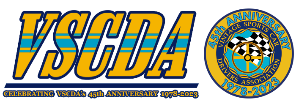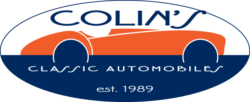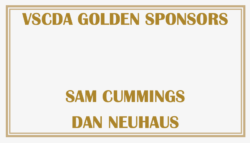All posts by admin
Summer Issue – 2015
Spring Issue – 2015
Winter Issue – 2015
Winter Issue – 2014
Fall Newsletter – 2014
August Issue – 2014
Car Steward & Tech Q&A
“For the Next Two Years…This Is a Test and Only a Test!” Don Tuscany, February, 2010
By: Don Tuscany, Car Prep and Classification Steward & Steve Bonk, Group 8 B-Sedan/TA Racer
The VSCDA Board knows our club’s future will depend partly on our ability to seek out opportunities to expand the cars and model years we accept. Also, in our Member Survey, many of you clearly asked the club to explore new opportunities. Steve Bonk and I, along with the full support of the Board and Eligibility Committee, are proud to announce a two-year test on expanding our racing groups and racing years.
On February 3, 2010 the Board voted unanimously to adopt a recommendation from the Eligibility Committee (Carl Braun, Paul Fitzsimmons, Yves Boode, Steve Bonk and Don Tuscany, Car Preparation Steward) to expand the C & BSedan/ Trans Am group eligibility. This is a two-year test in 2010 and 2011. This expansion will be for cars in the Under 2.5 Liter category and will expand racing opportunities to cars that fit and follow the SCCA Sedan/TA rules up to and including cars from 1979. We chose the 1979 cutoff since, in 1980, the GT series replaced B-Sedan.
The Eligibility Committee will convene at the end of the 2010 and 2011 seasons (or any time in between deemed necessary) to evaluate the test. If this change is determined to be a success at the close of 2011, a final rule set will be put in place. If not, we will revert to the current rules and car eligibility in 2012.
What’s New
The detailed rule set will be found on the VSCDA website shortly and will also be listed on Steve Bonk’s Trans Am B Sedan website at www.transam-bsedan.com. Here’s an overview:
- Create a new class in Group 8 for all C/B-Sedans (VSCDA or Guest TA). The class will be TA/Sedan – 2.5 liter & under.
- Create a Guest Racing Membership for TA/Sedan racers to participate in this expansion test.
- Extend an invitation for Guest racing to all TA/Sedan drivers currently not with VSCDA. During the test period, current VSCDA members are not eligible to present for tech inspection and entry any car built or otherwise acquired which conforms to the newly allowed “Guest” cars described in the new class (i.e., “TA/Sedan-2.5 liter and under”). Any car presented by current VSCDA members must conform to current VSCDA car preparation standards.
- Specific TA/Sedan rules will be in place, including:
- VSCDA will move all sedans in Group 8 (Alfa, Datsun, BWM, Fiat, or others) to the new category for the next two years.
Current VSCDA B-sedan racers (as of 1/1/10) must stay with present VSCDA Group 8 rules and car preparation during this test.
5. For Guest consideration, a racer can’t be a VSCDA member as of 1/1/10, or, if a present member, you must be presenting a totally new car which has raced with another VMC club at least twice in the preceding year under TA/Sedan rules.
6. Current VSCDA members will NOT be able under any circumstance to modify their cars for this group even if Guest racers present variations. This will include, but not be limited to, adding a 2L motor to Datsun 510s, later model heads on 2L Alfas, large or different brakes, suspension, or other modification opportunities.
7. For Guest cars, we will accept the cars as prepared for, and accepted by, any other legitimate, vintage racing organization. Legitimate is defined as “a club in good standing with VMC.”
Although it is not a VMC member, we will allow Midwestern Council (MCSSC V/H) sedan racers on an event-by-event test basis.
If a driver or vintage club is under VMC sanctions, the car/driver will not be accepted.
Guests will be required to file new documents with their first entry application. i. Fill out a new passport form on their car preparation with pictures – similar to CPS. ii. Submit copies of their log book issued from those VMC organizations and prove they raced the car the prior year (i.e., cover and race page with two 2009 date races). iii. Provide pictures of the car as raced during 2009.
All Guest cars will be tech’d to the passport and pictures, including weight, before they can be accepted for safety tech. There will be no Annual Tech’s for Guest cars in the TA/Sedan class. Steve Bonk, as expansion sponsor, will assist the Car Prep Steward at each race.
The VSCDA Car Prep Steward will reserve all rights to reject a car, even if raced with another vintage organization.
8. The following VSCDA conditions will apply:
VSCDA GCR tire rules apply – treaded DOT tires (under no circumstance are cheater Hoosier A6 or A8 or comparable slicks allowed), 50 series profile tires maximum allowed unless the Car Prep Steward approves an alternate for a unique situation in the passport.
Wheels/rims are given a maximum width of 1.5” plus production measure and strict compliance with rim diameter for all cars.
Guest TA/Sedan cars must carry the heavier of the weight that their “home club” requires in their GCR or 1 lb per cc of displacement (without driver).
The Car Prep Steward reserves the right to inspect any Guest or VSCDA TA/Sedan for rule compliance and weight. Strict compliance on all other TA/Sedan rules will apply, such as suspension components and attachment points, chassis modifications. No tube chassis, no custom suspension, limited suspension attachment points modifications, no coil over shocks, etc.
9. Finally, VSCDA reserves all rights to make any changes associated with this test as to rules, drivers, and groupings, including immediate cancellation of the test or series.
For further information, contact Steve Bonk at SSPMotorsport@aol.com or the VSCDA Car Prep Steward at hdbruce@comcast.net.
Car Stories and Photos – “A Fine Ride” April, 2010 By John Ruth
The road from refurbishing to racing to finally reaching the conclusion to part company with this 1966 Mustang has been a roller coaster ride. I have been and will continue to be a fan of the Pony Cars, especially the race cars. The car was refurbished some 11 years ago; it was not restored, and as a matter of fact, still wears its bluish / green 70’s exterior paint.
I did media blast the underside, cockpit and truck areas to ensure that they were sound and recoated in satin black ( the car originally sported black then a speckled paint finish in cockpit and truck ). The original suspect 4 point roll bar was removed and a safer 6 point roll cage installed along with a modern alloy driver’s seat, the cars low back fiberglass bucket seat was stored away. When media blasting, we found the original over-rider traction bars (cockpit floor mounts) to be less than ideal after years of racing, so some gussets in key areas were added prior to the re-painting. The lack of gadgets and modern flashing lights in the cockpit make it a welcome place.
The only updates are the steering wheel, since wood rimmed units are not preferred and in some cases outlawed, a Moto-Lita leather wrapped wheel is now fit and a safer alloy driver seat. Overall the cockpit is very period, utilizing the original factory top loader and gauges is refreshing, and helps recapture the spirit of 60’s road racers.
As mentioned, the exterior sports its early 70’s paint; I feel the paint after buffing out, and it looks very nice while not losing its patina. The engine is proper sized at 289 c.i.d. and is all iron. The engine block is one of the cars later units; it is a Boss 302 block, though filled with 289 Hi-Po crankshaft, and other internal parts making the overall displacement a 289 and still making some 440 hp. I feel keeping the original engine size is very important and using one of the original race blocks is another way to preserve history and performance.
The same can be said with the Mustang’s close ratio top loader gearbox and original Hi-Po tapered tube axle housing. Yes, modern gearboxes and the later straight tube 9” axle housings may be slightly stronger, but they are not correct, and I feel that should be the goal when refurbishing or restoring an historic race car. After all, the factory gearbox works just fine, if your engine is built with-in reason ( i.e. period specs ), and having that correct Hi-Po axle housing under the car just looks cool and is reliable when using proper tires and suspension parts. You may have gathered that I prefer having cars built to period specs, and using the original parts means that you as a driver get more of the original feel these fun cars provided in their hey-day.
Sure, the car’s exhaust may sound gruffer, the shifts are not as precise and notchy, and the original Detroit Locker rear diff makes noise as it grapples with the weight and power transfers. It’s all part of the character and part of having a car spec-d out per original terms. The car is built to be reliable and proper, and makes no excuses for being so.
The Mustang had some minor history from its original foray into racing down in Mexico. A small independent team converted the car from street to race, and somehow received token sponsorship from Shelby de Mexico, basically allowing them to buy parts at cost. The car is not a Shelby built car, but carries the Shelby design influences and FORD/Shelby parts. The car came back up to the States from Mexico and was used as a street car for some time when I finally came across it in Michigan. Its nose was sticking out of a garage, and I thought it looked a little tougher than the typical street Mustang, and it did. The bumpers were gone and the bright orange valance with large cutout where the license plate would typically be mounted indicated this car had character. I stopped and knocked on the door to ask about the car.
Seems the guy knew what the car was and did not give it a second thought. He called it an old Mustang that was hot-rodded. At this time, it did have a crazy small diameter steering wheel (colored metallic blue!) and had some strange alloy rims and large exhaust pipes ending in glass packs and a smallish looking roll bar. I came to the conclusion that this may simply be some tarted-up pony car and then decided to ask for the boxes located in the rear seat area to be removed, just to check the floor condition. This is when I saw something that caught my eye, and made me interested in where this car had been and what it had done in its past.
With the boxes and papers removed, I clearly saw the wheel houses were notched with rubber pieces popped riveted to close the holes ( the traction bars themselves were missing ) and the brackets themselves made clear the car was used for some racing – drag, autocross, etc. I then became interested in seeing more of the car, so asked to see the front suspension and rear suspension, noticing that the front A Arms were modified (cut/repositioned/re-welded and relocated on the car), the rear axle housing had over-rider mounts welded to a proper tapered tube Hi-Po 9” axle housing and 10”x2.5” brake baking plates with numerous drilled out holes. There was also the presence of a panhard rod bracket on the housing. In my mind, I now thought road racing … This car had a story and purpose behinds its looks, and since I wanted another Mustang road racer, I made an offer right then.
The guy seemed taken aback and then showed me more boxes of bits and pieces, where I saw a Shelby and Cobra hi-riser intake, old Holley carb, used Shelby Belanger drag headers and lots of misc parts. I could not take it all in properly – I only know the bug bit, and I wanted the deal. After some haggling, I ended up getting the car to my parent’s garage, which was closer than my own. A few weeks later the car came apart and I got to know every inch of the old car.
It was well into the tear down when I received a call from the last owner – he gave me a phone # that was outside the country and advised if I wanted to know more about the car to try to call and make contact. I did eventually get the call made, and found the # to be from Chile! I cannot speak any language other than English, so I had a friend do some translating and eventually it was agreed to conduct the “discussions” by letter. So my friend wrote a letter requesting details and I provided pictures of the car in its current state for him to reference.
I did receive one reply letter (that had to be translated into English) – he commented on areas of repair, modification etc. It ended up being that he was a part owner at one time and the main body man for the car. So he knew the condition as it was in the day – I also could see the areas where he pointed out race dings and repairs. I also received two rough pictures of the car when it ran Mexican Libre classes in the late 60’s. The car sported a large (read – ugly) hood scoop to clear some type of hi-rise intake system or intake trumpets.
I was able to complete the refurbishment in one year and finally joined VSCDA in racing the car in Group 6. The car raced with VSCDA at Gingerman, Blackhawk, and the great fall Road America event and at Grattan. Personally I really enjoyed Grattan with the Mustang. I suppose the highlight was when I ran nose to tail with the ex-Trans Am series (University of Pittsburg) Camaro. Both the cars were period correct and we changed places every couple of laps at the tight hairpin section. My car was a little under geared and had a slight disadvantage on the straight, so the Camaro would get really close as we neared the brake section going into corner #1. I think I won on Saturday’s race and he finished ahead on Sunday – what a fun time that was.
We also ran the car at Waterford Historic – this is certainly a handling track, and I can say that I always had a fun time going around that undulating short track. There are not many places a Mustang can use a 4.56 rear gear, and some of the guys use 5.11 gears – but really turn up the revs! In the 1960’s one local Mustang racer proved that the change from 4.56 to 5.11 gearing was worth about .75 of a second. So you can see the blast that a bog bore car could have at the historic track.
A lot of people say that racing a bog bore car is hard to do at Grattan, Waterford etc, though I think that the cars should be raced at tight tracks just as much as the fast tracks – same as they did back in the 60’s/70’s. As long as the field is made up of similar car types, no one should have too much of an advantage, and sliding these Group 6 cars around Grattan or even Waterford Hills is certainly a rewarding experience and teaches good car set-up and driver skill. I hope that the Group 6 grids rebuild and get out to the track in the numbers that make the field full of Trans Am type cars; they certainly bring the spectators to the fence and make for a great show.
I had a lot of fun and enjoyment studying the history of these cars and learning what is and what is not period correct. Overall the car helped shape my interest in historic race cars and impressed upon me the point that getting a car back to its roots is a very important part of our sport/hobby. I was the past Group 6 rep and met a lot of the fine drivers the group has, and conducted the past Gingerman 1 hour Group 6 enduros. In other words, I had a great time with the car and the Group 6.
All the best,
John Ruth
Ask the Expert – Un-storing Your Vee
Jim Schings, SR Racing, February 2010
The things required to get you ready for the first race after long term storage depend a bit upon what you did to store it in the first place. So, let me tell you what we recommend for long term storage and why.
- Drain the fuel cell. (Or if not easily done, fill it to the top.) One or the other is recommended by the Fuel Cell manufactures. This prevents the volatile compounds from evaporating and deteriorating the cell.
- Pump the carb throttle to empty ALL of the fuel from it. One of the biggest problems with long term storage is the nasty debris that will be left over in all the jets and throttle pump after fuel evaporation.
- Crank the engine with the throttle open and squirt some WD-40 in it. This keeps the interior of the intake manifold from rusting. (and they rust up fast)
- We usually loosen the rocker arm shafts to relieve the valve springs. Otherwise one or more springs will be fully compressed for the full storage term, causing a degradation in the spring rate at height.
- Keep a “Battery Tender” on it for the full storage period. They are trickle chargers that automatically shut off and on as needed to keep the battery at a float level. Keeping you battery at a float level will give you several years of use. Letting one drop to below 70% or 80% and then storing that way, vastly decreases its life due to sulfation.
So, if that or more is what you did to store it, bringing it out of storage will be easy.
- Tighten your rocker assemblies and adjust valve lash.
- Crank the engine without ignition until you read some oil pressure. Five pounds is plenty.
- Fill the fuel tank if emptied. (See above)
- Apply ignition and start it up. Let it idle for a while. Getting the oil temp up will make for an easier drain and will remove much of the humidity.
- Drain the oil and change the filter.
- Typically if you do a tune-up at the beginning of the season, do that now.
- Changing brake fluid, bleeding brakes and adjusting would be the next suggestion. Note that you will probably have some rust on the interior of the drums. It will come off pretty quickly. But before adjusting your brake shoes, you should drag the brakes a little and spin each of the wheels to clean them up.
- Regarding the step above, now would be a good time to grease front wheel bearings. If so, you will have your drums off so it will be easy to check the brake linings and lightly sandpaper the rust off the drums. Don’t adjust your brakes until after you have adjusted the wheel bearings.
- Depending upon how much time you have on the transaxle fluid you might want to change it now.
- Changing the fuel filter would also be in order.
Actually other than the normal alignment, bolt checks etc. that is all you will really have to do. Also do the same checks that the tech guys are going to do. Rain light working? Positive cable battery leads shielded correctly, etc.
However, you MIGHT have problems.
- It cranks, but won’t idle or start: More than likely evaporated fuel debris is in the carb internals. Does the throttle pump put a good squirt of fuel in the carb when you pump it? If not, you aren’t getting fuel to the carb, or one of the check balls in the carb throttle pump is stuck. You may have to remove the cover from the throttle pump and clean it out with carb cleaner. Also the fuel pump can go bad after sitting for a long term since that is when the rubber pumps get hard and brittle.
- If it’s an idle issue, you may be able to clear the passages in this way: Rev the engine up to a few thousand RPM and then immediately fully cover the carb intake with your hand, stalling the car. The heavy vacuum will often clear the orifices. If that doesn’t work you may end up having to open the carb up and start cleaning. Neither one of the above issues is typically a problem IF you did step 2 above when preparing for storage.
- If you have a cranking problem it probably is the battery, but other possibilities are:
- A internally corroded master kill switch. Turn it on and off several times. This will wipe the contacts.
- A defective starter bushing in the transaxle. This ALWAYS acts like a weak battery.
- Any loose battery to starter motor connections, etc.
If you are still having a problem, give us a call, we can walk you through it on the phone and get you going. Next year, if you follow all the proper storing steps you probably won’t have any problems.
SR Racing, 100 Mercer Ct. Suite 120, Lexington KY, 40511, sracing@mindpring.com 859-252-2496.
Visit Jim at SRracing.com.
Group 1 Report, March 2010
I joined VSCDA in 1981. My first event was Blackhawk Farms which then (pre global warming) was held in mid-October. At that time vintage was pre-1960 and the 37 entries were divided into 3 groups.
Group1 was pre-war and had 11 of the entries. Remember, Founder and President John Kleen’s 1939 BMW 328 was then 42 years old. It’s now over 70 years old and John isn’t far behind. Each group had their own race which was a Handicap race, the cars starting at various times based on their projected lap times. Then the groups were mixed and we ran “High Speed Trials,” where each car was required to do a specific number of laps in a given time. At the end of the day the track was kept open for another half hour and everyone was allowed to do touring.
We were our own corner workers so when you weren’t out on the track you manned the corners for the other group. A concourse was also held for all the race cars and a suitable prize was given in each class.
We no longer can expect almost 1/3 of our entries to be pre-war and only Tom Moore is still racing from that initial group. However, pre-war (except for the T-series MG’s) are all over that 70 year mark and it is fantastic to see them still on the track. We need to hope, however, that we can encourage new drivers to develop a feeling for these cars and their history and keep this as part of the VSCDA tradition.
This year we will have three Group 1 events, Blackhawk in June, Autobahn in July, and ELVF in September. I encourage all pre-war racers to support these events to the extent they can. I also encourage other VSCDA members to consider racing a pre-war car. It is an experience you’ll never forget!
Group 1 Brings Heavy Metal to Blackhawk
 An impressive total of nineteen cars filled out the Group 1 grid at the 19th Annual Blackhawk Vintage Classic. Although the weekend was filled with the usual racing excitement, sportsmanship and camaraderie, the highlight of the meet was something unique.
An impressive total of nineteen cars filled out the Group 1 grid at the 19th Annual Blackhawk Vintage Classic. Although the weekend was filled with the usual racing excitement, sportsmanship and camaraderie, the highlight of the meet was something unique.
Jack Heist, who raced with Group One for many years, has hung up his helmet and parked his TF in retirement. In honor of his racing career and support of Group 1, Denny Holloway led a parade lap, with Jack as his co-pilot, before the start of Saturday’s sprint race. With the entire Group 1 field following Denny’s TC around the track, Henry Adamson explained the significance of Jack’s last lap at Blackhawk to the crowd on the PA system. As Jack rounded the track, the crowd gave him an ovation. It was a touching and fitting tribute to a great racer and a good friend.
Saturday’s sprint race saw Matt Primack pilot the MG Lester to a relatively easy win over Augie Grasis’ 1933 Studebaker Indy racer. Rex Barrett, driving Lou Natenshon’s 1933 Ford Indy racer, was in the mix until fading brakes caused him to slacken his pace and finish third. Bill Goulette was first in his class with his 1933 MG J2, followed closely by Bill Lane in his 1947 MG TC. Kermit Wilson was third in class with his 1935 Morgan trike. Saturday’s race was also notable for Scott Forhman’s return to Group 1 after an absence of many years. His MG J2 was hampered by carburetor issues, but with near constant tinkering Scott was able to improve its performance each time out.
Sunday morning the spirit of vintage racing was amply demonstrated by the scene that played out in the Group 1 paddock. Rex Barret and Lou Natenshon were struggling to solve their car’s mysterious brake problems. Soon crews from up and down the pits came and offered expertise and hands-on help. For several hours the volunteers worked to get the braking system up to full function.
 In Sunday’s Feature Race, Rex Barrett, with his recently improved braking system, led flag to flag. Augie Grasis gave chase in his thundering Indy racer but was not able to close the gap. Marv Primack in the Lester figured to be in the mix and was, early in the race. An increasingly sour engine note caused him to slow and nurse the car home to a third place finish. Bill Goulette once again won his class. Curtis Liposcak took second place honors in his 1932 J 2/ C Type. Pat Norton took third in his class in his 1930 Ford sprint car. This result had to be particularly gratifying for Pat. In six previous attempts at Blackhawk, his car had broken down and been unable to make the starting grid for the Feature Race. Perseverance finally paid off.
In Sunday’s Feature Race, Rex Barrett, with his recently improved braking system, led flag to flag. Augie Grasis gave chase in his thundering Indy racer but was not able to close the gap. Marv Primack in the Lester figured to be in the mix and was, early in the race. An increasingly sour engine note caused him to slow and nurse the car home to a third place finish. Bill Goulette once again won his class. Curtis Liposcak took second place honors in his 1932 J 2/ C Type. Pat Norton took third in his class in his 1930 Ford sprint car. This result had to be particularly gratifying for Pat. In six previous attempts at Blackhawk, his car had broken down and been unable to make the starting grid for the Feature Race. Perseverance finally paid off.
The Blackhawk weekend was notable for the addition of two new members to Group 1. Nick Carso brought out his 1951 MG TD and Robert Ritholz raced his 1953 Morgan Flat Rad. With the guidance of instructors Tom Moore and Scott Fohrman, they were introduced to the joys of vintage racing. They drove well and safely and, by all reports, had a great time.


























